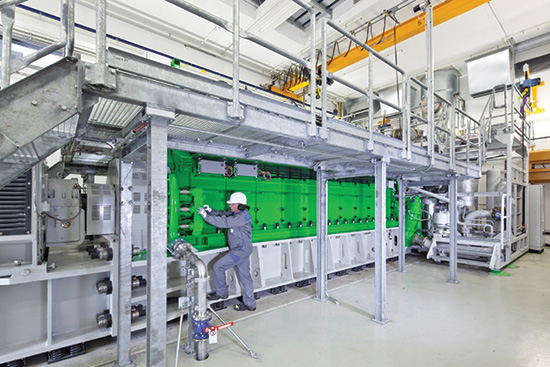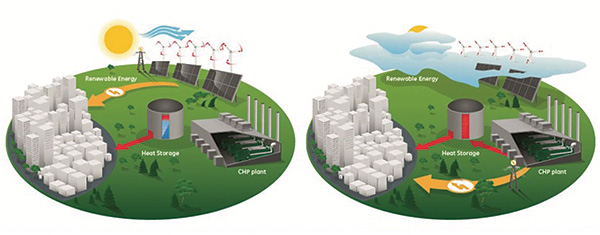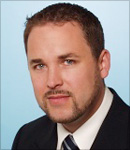The deployment of advanced distributed power technology is critical to the establishment of more flexible and dependable decentralized energy power supplies around the globe.
In fact, decentralized power is filling the needs of both developed and developing nations. On the one hand, decentralized power is in growing demand to stabilize the grid in developed countries, and greater generating flexibility is necessary to meet the needs of the rising renewables segment. On the other hand, remote locations can be serviced through distributed power without the time and cost of setting up transmission and distribution networks.
Premium flexibility, unlimited scalability
GE’s flagship gas engine fits these scenarios. It has the highest-in-class simple-cycle efficiency at 49 percent to lower investment and operating costs. It also offers efficiencies of more than 90 percent for combined heat and power (CHP) in a plant application that produces hot water, thanks to two-stage turbocharging. The turbocharging feature allows the GE gas engine to attain up to 3 percentage points higher total efficiency than gas engines that only offer single-stage turbocharging. And, there is no compromise on efficiency even in high-altitude and tropical regions. Since the engine is a modular system with a compact footprint, it’s scalable to any plant size and takes little time to install.

GE’s 10 MW class J920 FleXtra engine is part of the Stadtwerke Rosenheim municipal cogeneration plant in Germany
Because of their rapid start/stop cycles (the pre-heated engine has a five-minute startup time) and the excellent flexibility for baseload, cycling and peaking operation that comes from running multiple units simultaneously, the latest units provide strong power generation, district heating, decentralized independent power supply in remote areas and harsh environments, and grid stabilization for renewables support.
Since there is a great deal of dispatch volatility these days, gas engines face challenges with transient performance and compliance with grid codes. Without sacrificing plant efficiency or startup reliability, power plants must have fast-load tracking capabilities to meet peak demands and the need for ancillary services. The technology is designed for these challenges, as it includes a cylinder-individual combustion control system that uses in-cylinder pressure sensing, distributed controllers with imbedded software, and individual cylinder gas supply through port injection. These features enable the engine to provide load following, automatic generation control, and supplemental reserve without disrupting maintenance schedules or raising service costs.
The power generation mode embodied in this new gas engine also is a timely response to emerging global power demographics. Worldwide, energy power supply efficiency is only 33 percent, but the European Union has called for achieving 20 percent cuts in greenhouse emissions and primary energy consumption and a 20 percent gain in energy efficiency and the renewable portion of power generation by 2020.
With its large portfolio of gas engines, GE’s Distributed Power business offers the advanced technologies that deliver CHP, gas compression and waste heat-to-power electricity generation. These are the types of installations that are shaping the emerging low-emissions, smaller-scale, flexible power landscape that emphasizes efficiency in the production and delivery of heat and power.
Cases in point abound. For instance, the CHP technology cuts CO emissions at the Bitburg brewery in Germany by about 10,000 tons and has saved 10 percent on primary energy consumption since 2005. Three cogeneration units that supplied the 2012 London Summer Olympics with 10 MW of heat, power and cooling are continuing to heat and power homes and businesses in East London. A biogas agricultural power plant in Rawa Mazowiecka, Poland, runs on two units whose total efficiency is 86.6 percent. Poland’s largest flower grower is using CHP technology to post primary energy savings of about 40 percent in generating heat and power for its greenhouses.
CHP advantage: ramping up or down, as needed
There is a strong worldwide push for more wind and solar power; since 2010, installed capacity of these kinds of non-dispatchable installations has doubled, and that trend likely will continue. The right kind of power generation is necessary to support wind and solar energy within a stable grid. Flexible sources like this new engine can be activated when wind and solar supplies are slack or during tariff spikes and they can be cut back when energy prices fall and renewable power is plentiful.
That’s what’s happening in CHP plants that combine Jenbacher gas with heat storage. To a certain extent, the heat storage allows flexible power production in combination with a continuously required heat supply, so the CHP plant can be operated more flexibly. In a low-price or high-renewables environment, the plant reduces load and heat storage meets the heat demand. In a low-heat-demand or high-tariff situation, the gas engines supply the power and store heat for later usage. Hence, the heat storage affords a high level of operational flexibility that complements the use of wind and solar farms.
The beauty of CHP, as manifested by GE’s options, is its applications versatility, whether for district heating plants or the decentralized supply of power and steam or power and heat. In every case, primary energy savings are significant, when compared to separate production. An engine in operation uses the oil, mixture coolers and exhaust heat and waste heat from jacket water cooling to furnish the heat in a CHP plant. When heat and power are produced separately – the power coming from the national grid and heat from boiler generation – at least 50 percent more primary energy is consumed than by CHP. In one year, the J920 engine would use 130 million kWh less primary energy input than a plant that generates heat and power in separate formats. That’s equivalent to the energy produced by more than 76,000 barrels of oil.
Germany is a textbook example of the CHP dynamic in action, where CHP plants equipped with heat storage systems are complementing the environmentally beneficial but intermittent wind and power resource. Through the mechanism of the Renewable Energy Law passed in 2000, these facilities are being specifically subsidized in the interest of efficiency and emissions control, with guaranteed feed-in tariffs assigned to power that’s generated from renewable resources.
At the Stadtwerke Rosenheim, a German municipal CHP plant demonstrates how well the interplay of GE’s gas engines and the availability of renewables work to balance out the grid. It’s a typical plant of its kind, in that it supplies water, electricity, gas, process steam and district heating to residential and industrial customers. By adding the gas engine in 2012, the plant generates about 40 percent of the town’s electricity and about 20 percent of its heating.
In recent years, many Rosenheim residents installed rooftop solar panels, which can supply up to 10 MW to the local grid. But to account for weather-induced spikes in solar power, Rosenheim needed fast-reacting power generation from GE’s gas engines to stabilize the grid. Because the new engine is just as flexible as a smaller gas engine, with much higher electrical efficiency, it’s always the first engine to dispatch for peaking power in the city.
With the CHP plant storing heat in hot water tanks, the gas engines don’t have to operate all the time, and homes can stay warm without the reciprocating engines being run. When wind and power are abundant, the plant switches to them, and when district heating isn’t necessary, the engine supplies peaking and balancing power to the city’s grid.
Meeting the Grid Code Challenge
GE’s advancements in reciprocating engine technology also are meeting the challenge created in Germany by that country’s adoption of power supply network and system regulations known as the grid code – a phenomenon that other EU countries are adopting, though not to the extent of Germany. That was promulgated in 2013, when German energy suppliers had to begin assuring that national grid fluctuations wouldn’t adversely impact power generation and that the power plants themselves would enhance network stability. Under the new rules, the utilities that feed the grid must react within milliseconds to voltage drops and stay online even during grid instability Otherwise, the suppliers that fail to do this would be dropped from the grid – an event that could trigger a regional network breakdown and a widespread blackout.

CHP Plant operation with heat storage in conjunction with renewable power generation
The move to a grid code tracks Germany’s shifting energy stance that is emphasizing more alternative energy. Here, grid stability is more challenging for the likes of wind farms or photovoltaic collectors than for large-scale, stable power generating plants. This trend is also important beyond Germany, since the rules that country has implemented to provide decentralized energy supply within a dynamically stabilized grid will be pertinent throughout Europe. In fact, the first plant in Europe to support complete dynamic grid stability, and be grid code-compliant, became operational in 2010 in Mâcon, France, in a CHP configuration with three Jenbacher gas engines.
Not only are innovative technologies that neutralize grid volatility being made available on new units, but they also can be found on engines that are overhauled in the Jenbacher Overhaul Technology Center. GE’s Jenbacher solutions are conforming to the grid code reality by providing static and dynamic grid support -- and helping to shape the new energy order around the globe.
About the Author
 As of October 2013 Patrick Frigge is leading the 10 MW reciprocating engines Product line platform as General Manager for GE’s Distributed Power. Within this role he is also responsible for GE’s latest gas engine that was commercially introduced in April 2013. Prior to joining GE, Patrick was Director of Research and Development of Wärtsilä Switzerland Ltd. In this position, which he began in 2008, Patrick lead the central research and development unit for Wärtsilä’s newly developed two-stroke engines.
As of October 2013 Patrick Frigge is leading the 10 MW reciprocating engines Product line platform as General Manager for GE’s Distributed Power. Within this role he is also responsible for GE’s latest gas engine that was commercially introduced in April 2013. Prior to joining GE, Patrick was Director of Research and Development of Wärtsilä Switzerland Ltd. In this position, which he began in 2008, Patrick lead the central research and development unit for Wärtsilä’s newly developed two-stroke engines.
He has a master’s degree in industrial engineering and management from the Technical University in Berlin, Germany.
Distributed Power, which is focused on power generation at or near the point of use, is part of GE Power & Water, an operating unit of General Electric Company (NYSE: GE) and a world-leading provider of power generation, energy delivery and water processing technologies serving all areas of the energy industry, including wind, solar, biogas, alternative fuels, natural gas and nuclear energy.







